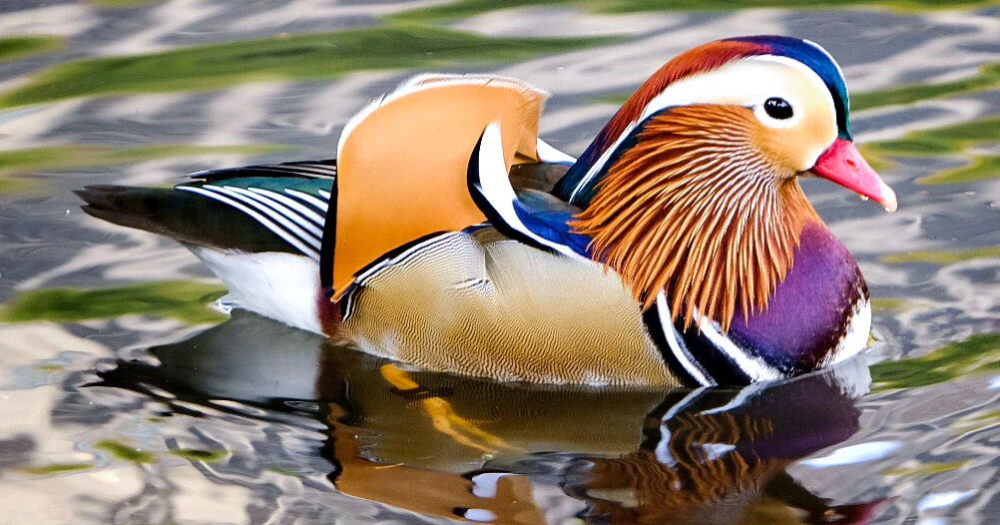The Mandarin duck (Aix galericulata) is one of the most stunningly beautiful birds in the world. It is popular for its vibrant plumage and significant cultural symbolism. Native to East Asia, these ducks have captivated humans for centuries, not just for their aesthetic appeal but also for their intriguing behaviors and ecological importance.
Physical Characteristics
The male Mandarin duck is particularly noted for its dazzling array of colors. During the breeding season, it displays a striking combination of orange “sails” on its back, a purple chest, orange cheeks, and a mix of green and blue on its wings. These vivid colors make the male easily distinguishable from the female. Females, in contrast, have more subdued, camouflaging brown and gray tones. The female, however, possesses a delicate beauty with a white eye-ring and a paler underbelly, allowing her to blend into her surroundings while nesting.

Habitat and Distribution
Mandarin ducks are originally from East Asia, primarily found in China, Japan, and parts of Russia. They inhabit forested areas near lakes, ponds, and rivers. These birds prefer habitats with dense vegetation that provides ample cover and nesting sites. Interestingly, Mandarin ducks have been introduced to various other parts of the world, including the United Kingdom and the United States, where they have established feral populations.
Behavior and Diet
Mandarin ducks are omnivorous, with a diet that changes seasonally. They feed on seeds, acorns, aquatic plants, insects, and small fish. Their foraging behavior is quite flexible; they can dabble at the surface of the water or dive to reach their food. During the breeding season, males perform elaborate courtship displays to attract females, which involve intricate dances and vocalizations.
One of the most remarkable behaviors of Mandarin ducks is their strong pair bonds. These birds are often cited as a symbol of fidelity and marital happiness in East Asian cultures. Unlike many other duck species that form new pairs each breeding season, Mandarin ducks can form lifelong bonds, making them an enduring emblem of love and loyalty.
Reproduction
Breeding season for Mandarin ducks typically begins in late spring. The female builds her nest in a tree cavity, often near water, and lays between nine and twelve eggs. After an incubation period of about 30 days, the ducklings hatch. One of the most astonishing sights in nature is the leap of faith taken by the ducklings when they leave the nest. Just a day or two after hatching, the mother calls them from below, and the tiny ducklings jump from the tree cavity, often from heights of up to 30 feet, to follow her to the water.
Cultural Significance
Mandarin ducks hold a prominent place in Chinese, Japanese, and Korean cultures. In China, they are often depicted in art and literature as symbols of conjugal love and fidelity. The birds are frequently given as wedding gifts to wish newlyweds a harmonious and happy marriage. In Japanese culture, they are also seen as emblems of love and fidelity, often appearing in poetry and traditional paintings.
The association of Mandarin ducks with marital happiness has its roots in their observed behavior of forming long-term pair bonds. This romantic symbolism has been reinforced through centuries of art, poetry, and folklore, making these birds an integral part of East Asian cultural heritage.
Conservation Status
Despite their enchanting beauty and cultural importance, Mandarin ducks face several threats in the wild. Habitat loss due to deforestation and urban development is a significant concern. Wetland drainage and pollution also pose serious threats to their natural habitats. In their native range, conservation efforts are underway to protect these habitats and ensure the survival of these magnificent birds.
In areas where they have been introduced, such as the UK, Mandarin ducks have adapted well, and their populations are stable. However, their impact on local ecosystems is still being studied to ensure they do not negatively affect native species.
Conclusion
The Mandarin duck is more than just a bird; it is a symbol of beauty, fidelity, and cultural richness. Its vivid plumage, intricate behaviors, and deep-rooted cultural significance make it a subject of fascination and admiration. As we continue to appreciate these extraordinary creatures, it is crucial to support conservation efforts that protect their natural habitats, ensuring that the Mandarin duck remains a vibrant symbol of nature’s splendor for generations to come.









